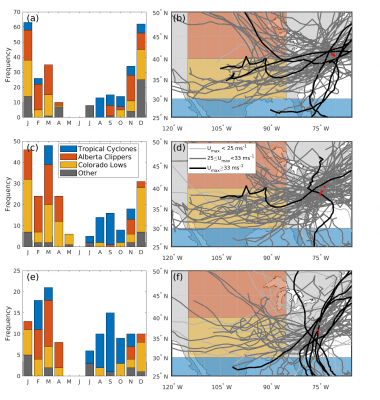Extreme Wind & Waves Aalong the U.S East Coast
Coastal infrastructure is vulnerable to the occurrence of extreme wind and wave events. Here we quantify the meteorological causes of extreme wind and waves and their probability of co-occurrence for the U.S. east coast. We further quantify low probability, long-return period wind and wave estimates along with uncertainty bounds for use in engineering applications.
We show that while tropical cyclones are particularly important drivers of extreme winds in southerly areas (e.g. off North Carolina), their importance greatly declines as one moves north up the east coast. For the Northeastern states, both the 50-year return period wind speeds at 100 m and significant wave height are higher than in more southerly locations. Annual maximum wind speeds and waves frequently derive from the same cyclone source and often occur within a 6 hour time interval, leading to high joint extreme loading on coastal infrastructure including, for example, offshore wind turbines.
Extreme wind and wave estimates are required for the design of a range of coastal infrastructure including offshore wind turbines. Here we quantify the meteorological causes of extreme wind and waves, their co-occurrence and quantify low probability, long-return period wind, and waves that are used in engineering applications.
This analysis employs 40 years of ERA5 reanalysis output, a cyclone tracking algorithm and Generalized Extreme Value distribution approaches to identify meteorological causes of extreme wind and waves along the U.S. east coast and develop robust estimates of long-return period wind and waves. A specific geographic focus is placed on the 16 offshore lease areas that have been auctioned for wind turbine deployments. It is shown that the fifty-year return period wind speed (U50) at 100 m a.s.l. in these lease areas ranges from 29.2 to 39.7 ms-1. After applying corrections to account for spectral smoothing and the 20-minute averaging period, the associated pseudo-point U50 estimates are 34 to 46 ms-1. The uncertainty in U50 estimates due to different distributional fitting is smaller than the uncertainty associated with under-sampling of the interannual variability in annual maximum wind speeds. Extreme wave statistics are also presented and indicate that the 50-year return period maximum wave height may substantially exceed 15 m. There is also evidence that annual maximum wind speeds and waves frequently derive from the same cyclone source and often occur within a 6 hour time interval leading to a risk for very high joint extreme loading on coastal infrastructure including offshore wind turbines.

